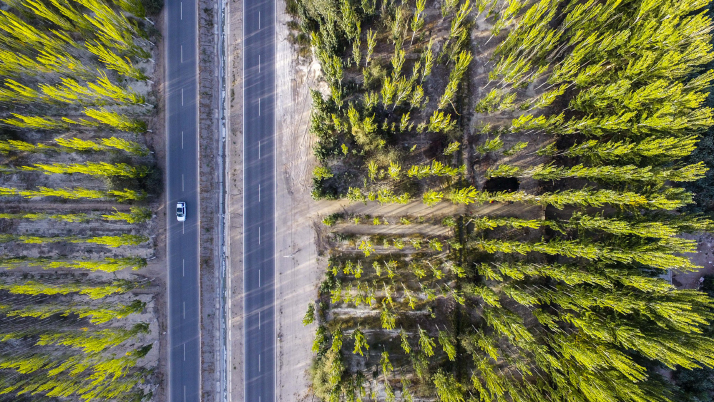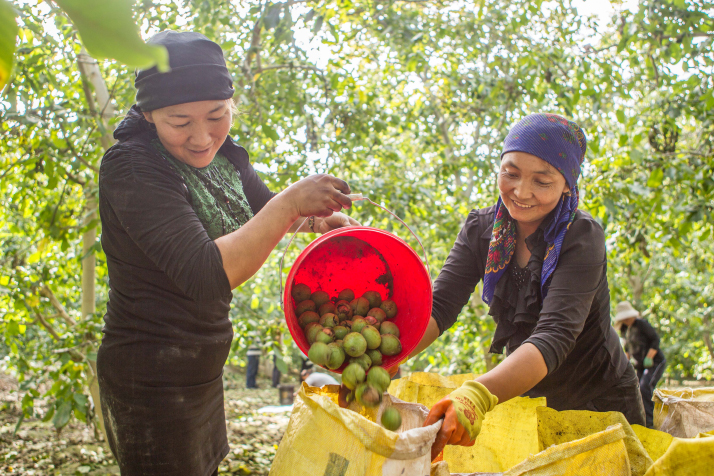| China |
| Xinjiang's Aksu has achieved a green transformation in the past three decades | |
|
|
 A road through the forest in Aksu, a prefecture in Xinjiang Uygur Autonomous Region, October 10, 2018 (XINHUA)
'When the apples in Aksu turn red, the whole country's apples are ripe." This is a proverb often quoted by fruit growers in Xinjiang Uygur Autonomous Region. Apples in other parts of China tend to be picked in August and September, while those in Aksu Prefecture, the main apple-planting area in Xinjiang, are picked at the end of October. As the temperature there drops sharply in autumn, the sugar inside the apples condenses rapidly, forming the "crystal sugar heart" unique to Aksu apples. In 2020, apple cultivation in the prefecture reached 25,300 hectares, yielding a total annual output of 795,800 tons, and a value of more than 3 billion yuan ($468.9 million). Last year, the fruit forest area in Aksu approximated 300,000 hectares, accounting for about a quarter of the total such area in Xinjiang, while the fruit forest industry contributed to around 31 percent of the per-capita net income of farmers. It is hard to believe that just 30 years ago, these orchards were desert. A harsh environment "When we were young, the environment here was so bad that no one wanted to come," said Aziz Hasan, a Uygur bus driver for a local tourism company. Born in Wensu County, Aksu, in 1974, he told Beijing Review that in the 1980s, the county was often ravaged by extremely strong sandstorms in spring and autumn, with more than 100 dusty days a year. "When the sandstorm came, we all hid at home. It would get pitch-dark, and we had to keep the lights on during the day," he said. The source of the storm is obvious. Xinjiang, located in northwest China, is divided into two parts by the Tianshan Mountains, with alpine grasslands sitting to the north and desert to the south of the mountain. Aksu lies between the Tianshan Mountains and the Taklimakan Desert. According to Li Xinbin, Secretary of the Wensu County Committee of the Communist Party of China (CPC), the desert was only 6 km away from Aksu, and was advancing at a rate of 5 meters per year. In this environment, even basic survival was difficult. People of all ethnic groups living there have tried to improve the situation. But a number of greening initiatives over the past two centuries ultimately ended in failure. Ecological miracle Nonetheless, people did not give up hope. In 1985, the government decided to build a shelterbelt against the main source of wind and sand in the northeast of the city. The afforestation project, known as the Kekeya Greening Project, lasted for more than 30 years, turning Aksu's greening dream into reality. The area was once a barren and salinized wasteland. While drought and water shortage were key reasons for the failure of previous greening projects, technical personnel analyzed local soil samples and found that its average salinization content was also higher than that suitable for afforestation. In addition to the harsh natural conditions, another major problem was a lack of financial resources. At the inception, afforestation machinery and equipment was in serious shortage. Aksu residents, especially CPC members and government employees, brought their own tools, without remuneration, to participate in the project. Almost everyone has planted trees in Kekeya. The soil was rock solid, so people needed to break the surface with a pick axe. Then large pits were dug, filled intermittently with a layer of sufficient fertilizer and a layer of soil so that the saplings could have nutrients to survive. Despite such efforts, the survival rate of seedlings in the first year was very low. But things began to change in 1987, when the first batch of 32 professional forest rangers entered Kekeya. Among them was the then 26-year-old Mamtimin Amut who joined the Kekeya Forest Management Institute that year. Recalling those years, he recently told Beijing Review, "With these natural conditions, forestry management is critical." Their expertise and efforts made a difference. Two years later, the saplings finally grew to the size of a human arm, basically able to survive. From 1987 to 1989, the survival rate of saplings in Kekeya rose to 87.5 percent, exceeding the target. In 1988, locals who participated in the tree planting received a small portion of red dates, the fruit of the jujube trees they planted. The dates were small and not sweet, but many people were moved to tears. In 1996, the 10th year of the project, the northern margin of the Taklimakan Desert finally appeared green on the remote sensing satellite map. In 2008, the city was rated as a national forest city, the first of its kind in northwest China. According to Aksu Forestry Bureau statistics, the project was essentially completed in 2015, with over 13.37 million trees planted under it. Over a period of 32 years, forest coverage in Aksu increased from 3.35 to 8.9 percent, and the urban green coverage rate reached 35.46 percent. The annual dust storms had been reduced by 61 percent.  Workers harvest walnuts in Wensu County, Xinjiang Uygur Autonomous Region on September 10, 2017 (XINHUA)
Green assets The Kekeya Greening Project is not a simple shelterbelt project. Of the 102,000 hectares of planted forests, 80 percent are forests that can be used for agriculture. From the beginning, policymakers clearly realized that if they simply planted shelter forests, the high maintenance cost would compromise their sustainability. Aksu's plan was to interplant apples, walnuts, dates and other crops into the shelter forest, with the government investing in tree planting, and then contracting farmers to manage the land and keep the economic surplus. This model sounded good, but difficulties arose because local farmers did not have much experience in planting walnut or apple trees. The apples began to bear fruit after seven years, yet the yield was low and their poor quality made it difficult to sell them at a good price. Technicians of Aksu Forestry Bureau have tried to solve this problem by teaching farmers the latest planting techniques and introduce high-quality varieties. "Crystal sugar heart" apples were cultivated by introducing Japanese Red Fuji apples into the area. And the results have been quite positive. Nowadays, Wensu County, the starting point of Kekeya Greening Project, has become a famous fruit production base in China, with the total output of fruit more than 20 times that of 30 years ago, and the income of fruit farmers also greatly improved. Many farmers who participated in the greening project have retired, but their descendants continue in their parents' footsteps, establishing businesses, building marketing networks, and promoting their brands. For Aksu, the journey continues. After 2015, new ecosystem restoration and protection projects have been set up. But unlike 30 years ago, locals no longer need to plant trees by hand. Instead, professional technicians and construction machinery do the heavy lifting. However, for the people of Aksu, the "Kekeya Spirit" of self-reliance, hard work and selfless dedication remains alive. BR (Print Edition Title: From Desert to Orchard) Copyedited by Ryan Perkins Comments to liangxiao@bjreview.com |
|
||||||||||||||||||||||||||||
|
